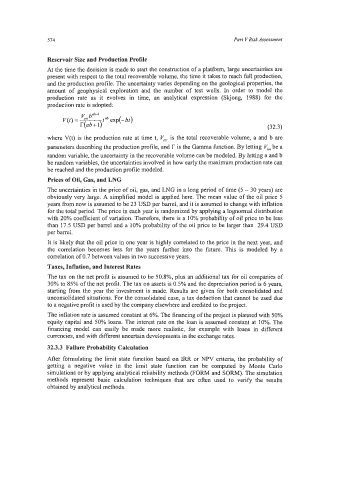Page 598 - Marine Structural Design
P. 598
574 Part V Rirk Assessment
Reservoir Sue and Production Profile
At the time the decision is made to start the construction of a platform, large uncertainties are
present with respect to the total recoverable volume, the time it takes to reach 111 production,
and the production profile. The uncertainty varies depending on the geological properties, the
amount of geophysical exploration and the number of test wells. In order to model the
production rate as it evolves in time, an analytical expression (Skjong, 1988) for the
production rate is adopted:
KOt b ab+'
tab exp(- bt)
V(t) = ___
T(ab + 1) (32.3)
where V(t) is the production rate at time t, Yo, is the total recoverable volume, a and b are
parameters describing the production profile, and r is the Gamma function. By letting KO, be a
random variable, the uncertainty in the recoverable volume can be modeled. By letting a and b
be random variables, the uncertainties involved in how early the maximum production rate can
be reached and the production profile modeled.
Prices of Oil, Gas, and LNG
The uncertainties in the price of oil, gas, and LNG in a long period of time (5 - 30 years) are
obviously very large. A simplified model is applied here. The mean value of the oil price 5
years from now is assumed to be 23 USD per barrel, and it is assumed to change with inflation
for the total period. The price in each year is randomized by applying a lognormal distribution
with 20% coefficient of variation. Therefore, there is a 10% probability of oil price to be less
than 17.5 USD per barrel and a 10% probability of the oil price to be larger than 29.4 USD
per barrel.
It is likely that the oil price in one year is highly correlated to the price in the next year, and
the correlation becomes less for the years further into the future. This is modeled by a
correlation of 0.7 between values in two successive years.
Taxes, Inflation, and Interest Rates
The tax on the net profit is assumed to be 50.8%, plus an additional tax for oil companies of
30% to 85% of the net profit. The tax on assets is 0.5% and the depreciation period is 6 years,
starting from the year the investment is made. Results are given for both consolidated and
unconsolidated situations. For the consolidated case, a tax deduction that cannot be used due
to a negative profit is used by the company elsewhere and credited to the project.
The inflation rate is assumed constant at 6%. The financing of the project is planned with 50%
equity capital and 50% loans. The interest rate on the loan is assumed constant at 10%. The
financing model can easily be made more realistic, for example with loans in different
currencies, and with different uncertain developments in the exchange rates.
32.3.3 Failure Probability Calculation
After formulating the limit state function based on IRR or NPV criteria, the probability of
getting a negative value in the limit state function can be computed by Monte Carlo
simulations or by applying analytical reliability methods (FORM and SORM). The simulation
methods represent basic calculation techniques that are often used to verify the results
obtained by analytical methods.

